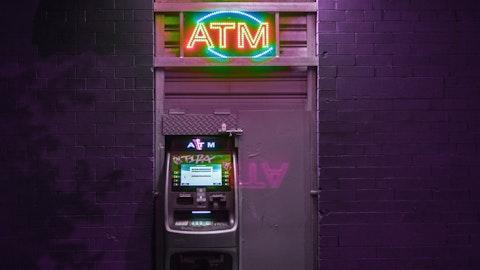John Pancari: Got it. All right. thanks Mike.
Operator: Our next question will come from Mike Mayo with Wells Fargo Securities. Fargo Securities. You may now go ahead.
Mike Mayo: Hi. I hear you about the expense guide for next year is 0% to 1%. So, that would be better, and I hear you about taking the tough actions. But then I look at the core efficiency ratio of around 60%, and it’s not what investors signed up for when you announced the merger, even recognizing the rate headwinds and other things. I don’t think it’s where you wanted to be. So, as you embark on what maybe you could call Truist 2.0 as compared to Truist 1.0, how is management changing in terms of the time to make decisions? Truist 1.0 was like selecting best of breed, it seemed to take a long time. Maybe that was slowed down by such a large board, which now is getting reduced. How is Truist 2.0 better on intensity? How is Truist 2.0 better in terms of moving shareholders up the pecking order?
And I guess, generally, with all your optimism, Bill, that certainly is not reflected in the share price, and there’s a lot of frustrated and disgruntled shareholders out there. So, how can Truist is 2.0 with the $750 million of savings, maybe strategic actions with insurance, intensity and the way you manage, help shareholders more?
Bill Rogers: Yes. Mike, thanks. The intensity is – I don’t know what superlative to use other than high. So, the intensity is really good. And what’s happened with the cost save program, and we talk about the $750 million in cost saves, but I don’t want to diminish the simplification of our business. So, creating these consumer and wholesale towers and creating the simplification of our business, that really has allowed us to move a lot faster. So, I’ve been really pleased with how the team has embraced this whole process. I mean, leaders are stepping up in really demonstrable ways, getting in front of it and they’re making decisions at a much, much faster pace. So, I outlined a bunch of the different consolidation and those type of things.
Those would have been more sequential in the past. You sort of do one, you another one, you sort of go through the process. And today, they’re all on these great parallel paths. And I think that’s going to have a faster, longer-term impact. And look, I mean, to your point, I mean, we’re not happy with where the efficiency is now. One of them stated that as publicly possible and we have demonstrable plans. We talked about the overall play on the cost saves. But long-term, that also has to result in better revenue growth. And all the things that we do together of bringing these businesses together, optimizing the balance sheet, creating capacity, creating product and capability, training our teammates, having them lean in, demonstrated net new, all the things that are building in terms of the momentum, those are key.
And I can assure you, for our Board, we have presented an improvement plan on the efficiency ratio, long-term improvement plan. And we’ll be on that track. I mean, we share your frustration, trust me. But I think we’ve got now the structure in place, the leadership in place, the commitment, the intensity, support and we’re moving fast. And our team can feel it and they’ve embraced it.
Mike Mayo: Just as a follow-up, since you did present a plan to the Board for the efficiency ratio, I don’t think consensus expects much improvement next year. I guess next year is going to be tough to have positive operating leverage. But if you could comment on that. And maybe just a little bit more meat on the bones. You gave a lot, one-third less bank region, one payment business. Any other color you can give on the efficiency. And when you say simplification, I mean, you guys aren’t Citigroup, right? It’s not like you’re in 100 countries. You’re in adjacent regional markets where you should be able to be a lot more simple than what happened after the merger. So positive optimal leverage, improvement in efficiency next year, is this really, as you say, a long-term plan?
Bill Rogers: Yes. On the – they’re just as with efficiency, there is a positive operating leverage long-term plan in all of our businesses. And part of the simplification allows them to control that destiny and make decisions about that on a faster basis. It will be harder in the first part of next year. I mean, as you know, I mean, you’re sort of running off an NII comparison. So that’s just the tougher hurdle. But as we get into the latter part of next year, I mean, we’re going to see continuous improvement and commitment to that on a long-term basis. So I can’t – without sort of a rate forecast and all that, particularly, I can’t comment exactly. But I can comment that during the second half of that, of next year, you’re going to start seeing a lot of improvement on the operating leverage and going into 2025, we’ll be firmly committed and be a really good flight path.
And then as you – and then to the simplification things, we’ll continue to – it’s a really good question. We’ll continue to outline some of those. I mean just think about, for example, care centers. I mean, we have a lot of care centers serving a lot of different businesses. In the merger. We needed to bring those all over the transom and have them perform well. We’ve invested in a lot of technology and we can consolidate care centers. Just think about that as one of dozens and dozens of examples of this component of simplification. So while I agree with you, we’re not sort globally in 100 countries or whatever that parallel may have been, but we still have a lot of opportunity to make this company simpler, faster, leaner and more responsive to clients and as you noted, more responsive to shareholders.
Mike Mayo: All right. Thank you.
Operator: Our next question will come from Matt O’Connor with Deutsche Bank. You may now go ahead.
Matt O’Connor: Good morning. Can you guys elaborate on the service charge issue? Was that that something was kind of self-identified? Was it driven by the CFPB? Or – we haven’t seen that at peers, least not yet. Can you elaborate what happened there, please?
Bill Rogers: Yes, Matt. This is Bill. Yes. We did that on our own volition. I mean, we’ve looked at all of our products and offerings. We’ve listened to a lot of client feedback. We reviewed and changed our protocols with respect to deposit-related fees. And that resulted in refunds that did impact revenue and other expense. I think we’re taking just a more contemporary view of sort of where the world is, where the puck is going and making sure that we get ahead that, we’re staying in front and creating this clearer path as possible for next year and the continuous improvement we want to make in our business.
Matt O’Connor: And then how do we think about the run rate of the service charges given these changes? Obviously, we’re not going to run rate to $152 million. But I guess would assume it’s lower than previous quarters if you implemented changes going forward?
Mike Maguire: Yes. Look, I mean, I think there’s been pressure on this item in general, just given the evolution of the service charges on deposits. But I think you can safely assume that the $87 million that we’ve noted here during the third quarter was a quarter event. So, again, I think you should expect there to be the same style of pressure you’ve seen on this line item sort of trending in the industry and for Truist, but this particular event wasn’t sort of a step functional driver.





